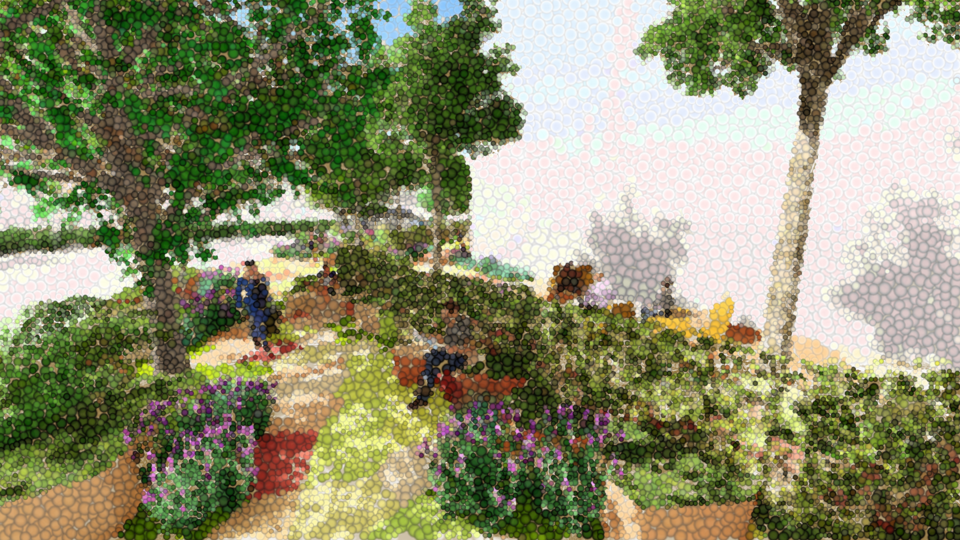
Abstract
Trencadís transforms a transitory sidewalk to resident alcoves through the implementation of trencadís, a dynamic mosaic art form that responds to the distinctive needs and material preferences of its creators. The design approach is centered on understanding and reacting to resident preferences to resolve site challenges. Non-descript materiality is replaced with a parametric, pervious mosaic base, high tourist volume with exterior tourist paths and interior resident rooms, and poor environmental conditions with semi-opaque screens that filter noise and air pollution.
Trencadís, developed by Antoni Gaudí as part of the Catalan Modernism movement, is known by various names like pique assiette, broken tile mosaics, bits and pieces, memoryware, and shardware. Present on the towers of Sagrada Familia, the mosaic art form crafts from cemented tile shards and broken chinaware.
Introduction
The site design was informed by the engagement of residents to improve the conditions for the natural, living, social, and cultural worlds.
The participatory process gleamed resident preferences from 27 semi-structured interviews with residents of the Barrio, business owners, and tourists and 20 image generations. This inclusive approach ensured the evolving design cater to the unique desires, aspirations, and concerns of those who call this community home. Synthesis of participatory findings mapped resident preferences to site challenges. Environmental stressors are mitigated by dense, verdant planting, multistory canopies, and calmed traffic. Identity and ownership are expressed by a mosaic base and attribution of tiles during the construction phase.
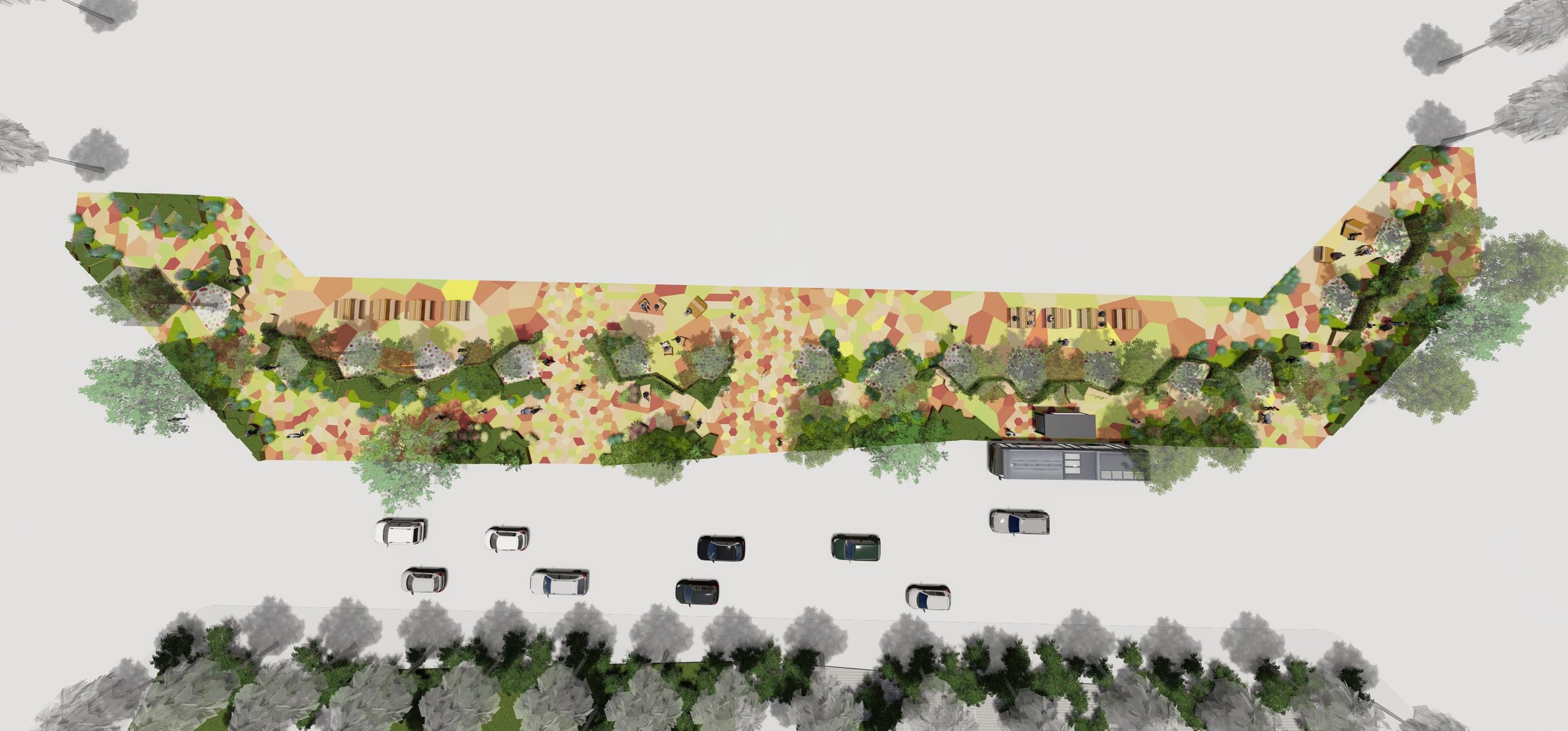
Framework Design
The design framework for this project was anchored in a comprehensive understanding of the site’s living, natural, cultural, and social contexts. Through site analysis, engagement, and synthesis, the framework addressed challenges related to poor environmental conditions, limited gathering spaces, high tourist traffic, and a lack of cultural representation.
Key Challenges and Resolutions
Environmental Conditions | Planting green areas with multistory canopies acted as carbon sinks, acoustic and visual filters, while responsive cell sizing facilitated drainage.
Gathering Spaces | Alcoves were introduced to provide adaptable spaces for residents, enclosed with noise barriers to enhance privacy and prevent visibility to the street.
Traffic Management | Tourist paths directed non-resident traffic externally, and a tapered bus lane was designed to calm traffic on Calle d’Aragon while shielding an interior resident path.
Cultural Representation | Resident material preferences were addressed through mosaic tiles attributed to residents of different cultural backgrounds, fostering a sense of identity and ownership.
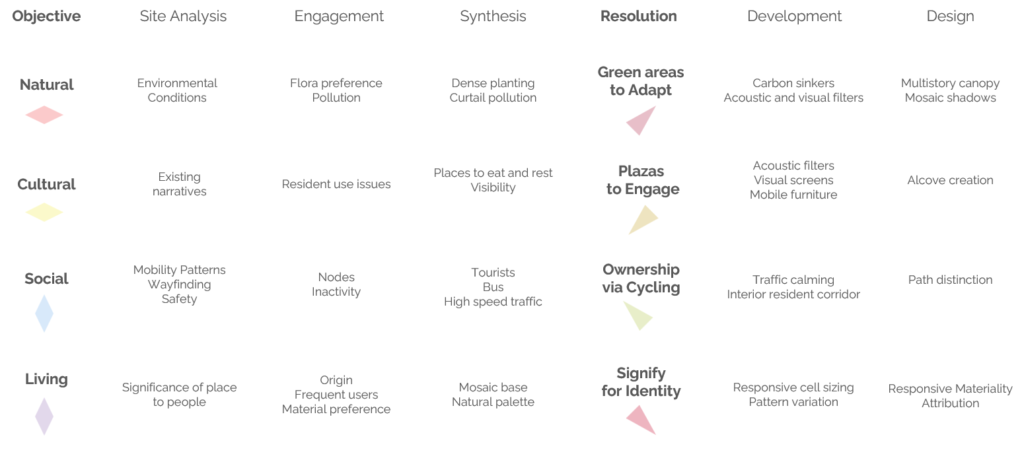
Site Analysis
The site analyses included locating demographic baselines for age and origin, the site in the context of monuments, and activities that define its opportunities and constraints. The age and origin of residents in both the Barrio and Eixample districts revealed the mosaic as a common cultural symbol. Understanding the site as the median between Monumental and Sagrada Familia landmarks guided the embrace of the mosaic pattern as a primitive geometry. Examination of land use, zoning regulations, and mobility patterns offered a comprehensive understanding of the site’s functional dynamics, guiding the strategic positioning of the resident interior path. Safety considerations, such as the prevalent issue of parking on sidewalks, are meticulously studied, influencing the path’s design to ensure a secure and obstruction-free passage for residents. Consideration of natural elements, modularly placed trees, and non-natural elements such as trash cans, bus stations, and wayfinding structures, informed the thoughtful integration of the resident interior path, creating a harmonious and functional community space grounded in a mosaic.
Existing Narratives
Meaningful community engagement was facilitated through 27 semi-structured interviews and participatory design techniques. Stakeholders, including residents, business owners, and tourists, provided valuable insights to shaping the design process. Tourist traffic, noise from the street, and air quality emerged as immediate concerns needed to be addressed through the development of resident-specific spaces. Specifically, pedestrians and residents of upper-story apartments are unable to converse on site and in their homes. Dog walkers and parents with children elect to walk on the opposite side of the street to avoid safety issues with motorcycle and car parking on sidewalks. Tourists provide meaningful business but droves coming to and from transit and Sagrada Familia detract from the resident experience. Broken and dull pavers, blank facades, lack of shade were identified as detracting visual elements from the experience of walking on site.
Participatory Design
Customized participatory design techniques were employed to adapt to the transient nature of the site. Image-generation exercises, utilizing an online survey, print-out of possible selections, and drawing of site elements leveraged artificial intelligence to imagine and diffuse residents preferences for furniture, patterns, colors, plants, and mosaic designs into imagery that guided the material selection.
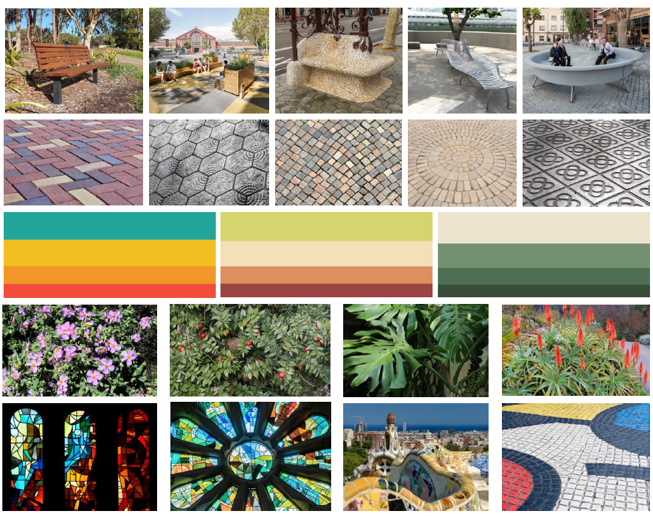
Preference identification | Preferences were set to be gathered with Google form and over a print-out of selections. Survey elements—furniture, pattern style, color palette, plants, and mosaic type—were influenced by local and international plaza designs, interviews, and anticipated site solutions, providing a versatile palette for residents. Direct, guerilla engagement of pedestrians was quickly identified as the only effective method to gather preference data.
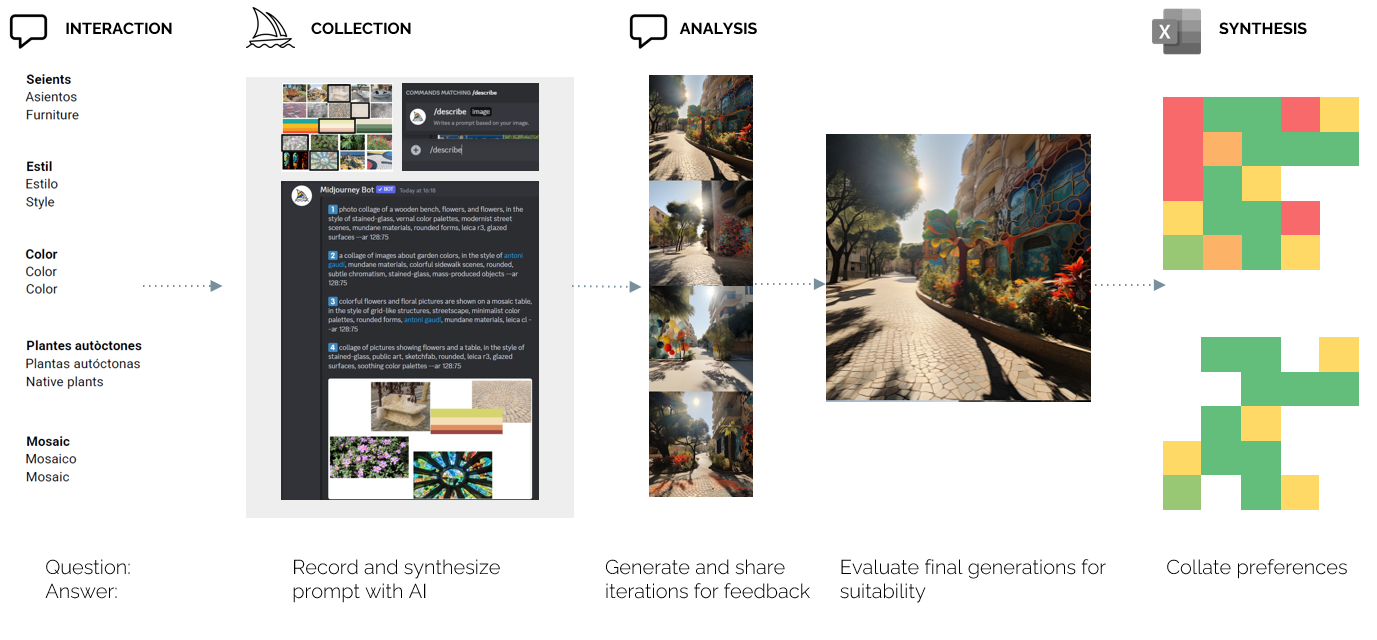
Interactive diffusion | The participatory process diffused resident preferences using stable diffusion intelligence into the evolving site plan. Although the initial on-site diffusion exercise proved time-intensive for pedestrians, hindering immediate implementation, the potential for this method to holistically infuse resident preferences into the site remains promising. With planned engagement strategies and a different setting, the Stable Diffusion process could offer a nuanced understanding of where residents specifically desire certain design elements.

Despite time constraints limiting the feedback loop of preference efficacy, the MidJourney design method proved invaluable in capturing initial resident preferences and offering a dynamic visual representation of the transformative potential.
Synthesis
The analysis focused on celebrating identity and empowering the community. Strategies were employed to reduce tourist traffic, create engaging spaces, and attribute mosaic tiles to residents during the construction phase.
Resident preferences were collated into findings by identifying the purpose of each element’s selection. Furniture was selected for its mobility, material, and integration with site elements. Seating is mobile to respond to need for flexibility in land use and wood. Noise barriers weave through the existing trees like the zipper bench. The geometric pattern is mosaic and hexagonal, sensitive to the labor and cost intensive nature of mosaic construction. The paving color is in the natural palette while dense planting responds to the desire for green on site. The natsuriums indicated the desire for dense, low planting while monstera was a crowd favorite type. The mosaic narrative of Sagrada informed the attribution, allowing residents to infuse their histories in the site, and structure of Parc Guell informed the desire for randomness in mosaic geometry.
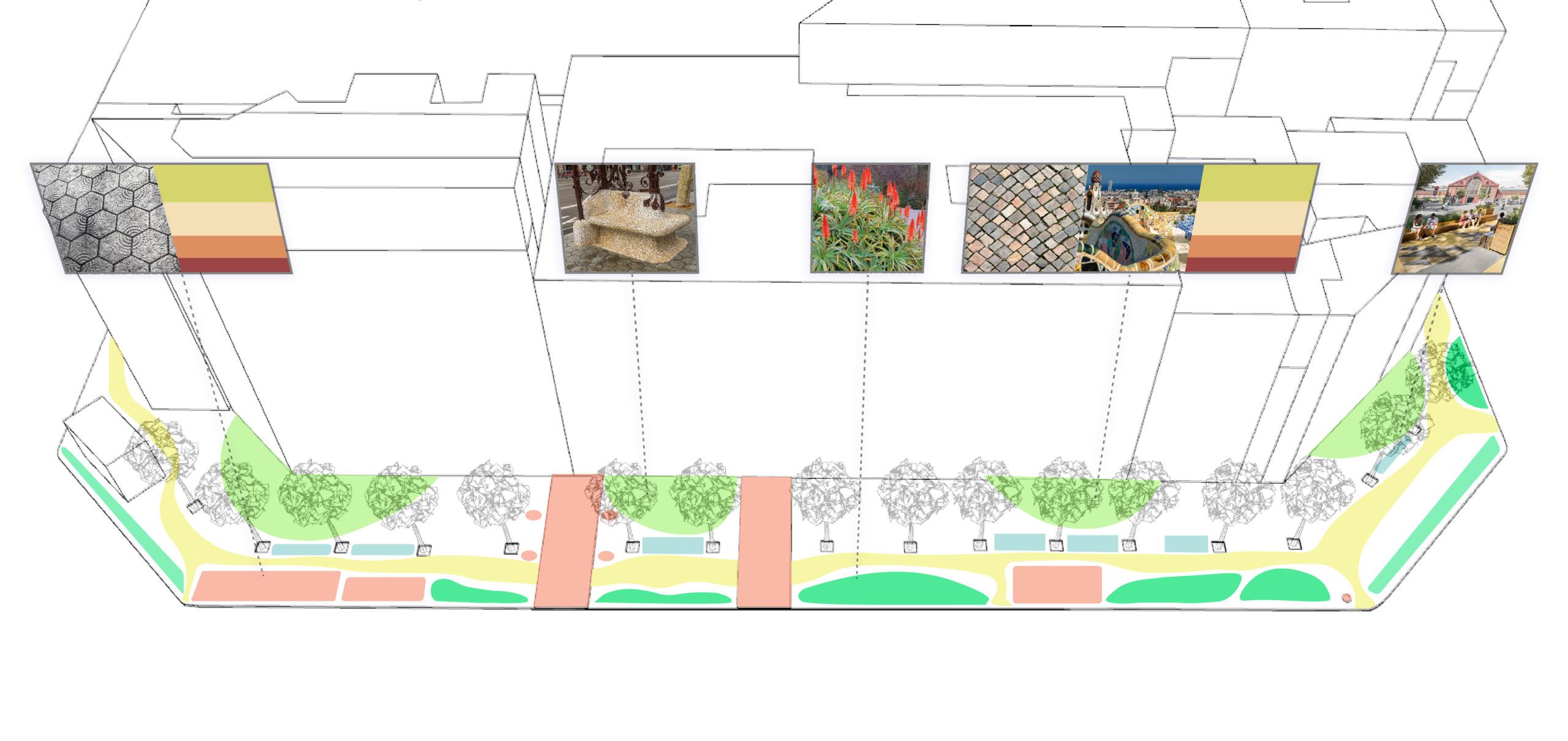
Collating resident preferences shaped material and form selections.
Furniture | Selections informed furniture mobility, material, and integration with static site elements. Mobile seating, responding to the need for flexibility in land use, incorporates wood to harmonize with the surroundings. Noise barriers, inspired by the zipper bench concept, delicately weave through existing trees.
Pattern | The geometric mosaic pattern, the favorite geometry across category selection integrates with hexagonal tiled pavers, to respond to both the labor intensity and cost-effectiveness of mosaic construction.
Color | Paving color in the natural palette was selected by residents and blends into the site’s surroundings. Dense planting aligns with residents’ wishes for vibrant green spaces. Specific plant choices, such as nasturtiums for dense, low planting and the popular monstera variety, further informed flora selection.
Mosaic | The mosaic narrative of the iconic Sagrada Familia influenced the attribution process, allowing residents to infuse their histories into the site. Additionally, the structural randomness of Parc Guell influenced the desired mosaic geometry, introducing an element of unpredictability and creativity as well as reverence of Sagrada Familia.
Non-Human Focus | Environmental awareness and inclusion of non-human stakeholders were central to design decisions. The incorporation of a multi-story canopy and greenery not only improved residents’ well-being but also created a biodiverse and ecologically supportive urban ecosystem.
This meticulous alignment of resident preferences with material and form selections weaves a narrative that honors the site’s natural and cultural contexts, empowering residents to contribute their unique stories to the evolving fabric of the urban space.
Technical Language
A generative system and technical language were developed, considering fixed barriers, land uses, and user types. The mosaic base was strategically designed to reduce tile density at activity nodes, existing and potential alcoves, and allow for permeability at natural nodes.
Randomizing the mosaic | A mosaic base is developed by randomizing tile centroids to be approximately 3m away from their neighboring tiles to control initial tile size.
Identifying nodes | Constraints were populated on the site to deviate the size of pattern geometries. First, Alcove Areas were located and given a radius of influence. Pre-existing programs including the Colombian bakery and the Spanish Bar and Restaurant were allocated a larger radius, (~15m). Future Alcove Areas were selected to drive program where no current the space is current underutilized and were allocated a smaller area of influence (~10m). These areas include those between resident garage driveways and on the abandoned right corner of the sidewalk.
Identifying barriers | Barriers of transit, or tourist paths, on bordering streets alters the current mosaic pattern at the edge conditions of exterior Alcove Areas.
Varying density by node | The pattern is revised by evaluating each tile based on its distance to the closest geometry of interest and are reduced based on their proximity to Barriers of Transit. The closer a tile is to a Barrier of Transit and the farther from Alcove Areas, the smaller they are. This results on a new mosaic pattern responsive to activity type, densifying near Barriers of Transit to offer and providing space near Alcove Areas.

Varying pattern by replacement cost | The flexibility of the mosaic pattern allows for its adaptation to geometries of interest, but the unique nature of each tile require constant consideration of its feasibility. Challenges emerge on site where flooring is exposed to wear and tear. To tackle this, hexagons, the secondary geometry selected by residents in the participatory activity, are implemented by graduating the pattern development.
Extending over a lane to calm traffic | To tackle noise pollution, the sidewalk extends over the first lane of Calle d’Arago, forcing traffic to slow and reducing the noise. The sidewalk maintains its width where the bus stops and extends to encompass a full lane by the light change.
Removing for permeability | Lastly, to add green space, mosaic tiles are removed for permeability where there are understory plants. Elected tiles follow a similar selection process as those for Barriers of Transit and Alcove Areas. The resulting green area of the site is ten times the existing design, from 3.5% to 35%.
Extruding for visual obscurity | Mosaic tiles are extruded (~1.5m) to create noise barriers woven among taller plants, dividing alcoves from paths.
Design
The design solutions showcased a deeper and more sensitive approach to expanding urban natural environments and human-nature relationships. Trencadís and other elements were thoughtfully integrated to harmonize with the existing ecosystem.
Designing both in collaboration with the neighborhood and in response to site conditions required careful consideration of non-anthropocentric needs. Neighborhood preferences and feedback directed our attention toward the collective problem of noise pollution, heavy traffic, litter, and lack of attractiveness. Challenges were met by employing dense vegetation around the roadway and alcoves to function as noise buffers, and visual barriers from the street. More importantly, vegetation would soften hard edges of the site, provide a living layer of trees, shrubs, grasses, groundcover, trailing vines, and climbing vines along trellis structures. This living layer of greenspaces, pathways and site furnishings consist of pieces as a mosaic, fitting together with intention to provide clean air and greenspaces to restore a sense for residents. Furthermore, visitors are able to slow down and find rest in the alcoves designed to function as meeting points or places of calm for residents.
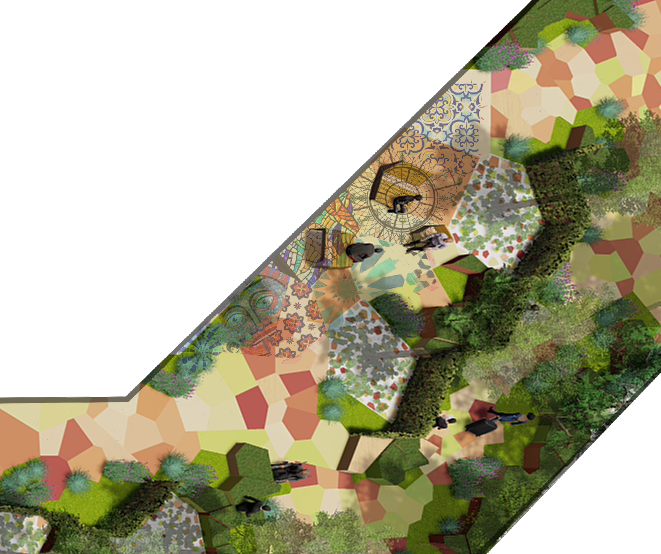
Conclusion
In conclusion, this transformative project exemplifies how trencadís, a participatory approach, and environmentally conscious design can create spaces that resonate with the cultural identity of Barcelona and agenda of Eixample Respira to foster a sense of ownership and community pride.
Directly responsive to site conditions, the finalized site design is not replicable but each participatory processes may be replicated to design for resident preferences. Site conditions must inform survey element selection and residents must expect to spend time on site to effectively execute interactive diffusion. Sites with similar conditions may leverage the design as a precedent. Sites facing noise and air pollution may recess resident spaces; plant dense, multistory canopies; and calm traffic. Those facing high tourist volumes may direct traffic with exogenous paths. Universally, sites may ensure adaptability to changes in use with mobile, modular furniture.

